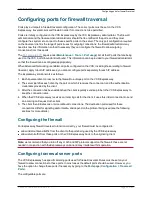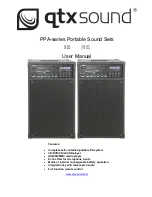
Configuring Expressway and traversal endpoint
communications
Traversal-enabled H.323 endpoints can register directly with the VCS Expressway and use it for firewall
traversal.
The
Locally registered endpoints
page (
Configuration > Traversal > Locally registered endpoints
)
allows you to configure the way in which the VCS Expressway and traversal-enabled endpoints
communicate.
The options available are:
Field
Description
H.323 Assent
mode
Determines whether or not H.323 calls using Assent mode for firewall traversal are allowed.
H.460.18 mode
Determines whether or not H.323 calls using H.460.18/19 mode for firewall traversal are
allowed.
H.460.19
demux mode
Determines whether the VCS Expressway operates in demultiplexing mode for calls from
locally registered endpoints.
On
: uses the media demultiplexing ports for all calls.
Off
: each call uses a separate pair of ports for media.
H.323
preference
Determines which protocol the VCS Expressway uses if an endpoint supports both Assent and
H.460.18.
UDP probe
retry interval
The frequency (in seconds) with which locally registered endpoints send a UDP probe to the
VCS Expressway.
UDP probe
retry count
The number of times locally registered endpoints attempt to send a UDP probe to the VCS
Expressway.
UDP probe
keep alive
interval
The interval (in seconds) with which locally registered endpoints send a UDP probe to the VCS
Expressway after a call is established, in order to keep the firewall’s NAT bindings open.
TCP probe
retry interval
The frequency (in seconds) with which locally registered endpoints send a TCP probe to the
VCS Expressway.
TCP probe
retry count
The number of times locally registered endpoints attempt to send a TCP probe to the VCS
Expressway.
TCP probe
keep alive
interval
The interval (in seconds) with which locally registered endpoints send a TCP probe to the VCS
Expressway after a call is established, in order to keep the firewall’s NAT bindings open.
Cisco VCS Administrator Guide (X8.1.1)
Page 62 of 507
Firewall traversal
Configuring Expressway and traversal endpoint communications
















































